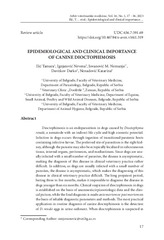Приказ основних података о документу
Epidemiological and clinical importance of canine dioctophymosis
| dc.creator | Ilić, Tamara | |
| dc.creator | Ignjatović, Nevena | |
| dc.creator | Jovanović, Nemanja M. | |
| dc.creator | Davitkov, Darko | |
| dc.creator | Nenadović, Katarina | |
| dc.date.accessioned | 2023-07-26T08:42:15Z | |
| dc.date.available | 2023-07-26T08:42:15Z | |
| dc.date.issued | 2023 | |
| dc.identifier.issn | 1820-9955 | |
| dc.identifier.uri | https://vet-erinar.vet.bg.ac.rs/handle/123456789/3033 | |
| dc.description.abstract | Dioctophimosis is an endoparasitism in dogs caused by Dioctophyma renale, a nematode with an indirect life cycle and high zoonotic potential. Infection in dogs occurs through ingestion of transitional/paratenic hosts containing infective larvae. Th e preferred site of parasitism is the right kidney, although the parasite may also be ectopically localized in subcutaneous tissue, internal organs, peritoneum, and mediastinum. Since dogs are usually infected with a small number of parasites, the disease is asymptomatic, making the diagnosis of this disease in clinical veterinary practice rather diffi cult. In addition, as dogs are usually infected with a small number of parasites, the disease is asymptomatic, which makes the diagnosing of this disease in clinical veterinary practice diffi cult. Th e long prepatent period, lasting three to fi ve months, makes it impossible to diagnose the disease in dogs younger than six months. Clinical suspicion of dioctophimosis in dogs is established on the basis of anamnestic/epizootiologic data and the clinical picture, while the fi nal diagnosis is made ante mortem or post mortem on the basis of reliable diagnostic parameters and methods. Th e most practical application in routine diagnosis of canine dioctophimosis is the detection of D. renale eggs in urine sediment. When dioctophimosis is suspected in carnivores, the diff erential diagnosis should exclude urinary capillariosis, feline polycystic nephropathy, leptospirosis, renal fi brosis, and nephritis of various etiology. Th e outcome of treatment is uncertain and includes surgical removal of the aff ected kidney or drug therapy with avermectin derivatives. Prophylaxis consists of preventing contact of dogs with potential transitional hosts and controlling the feeding of their heat-untreated meat. Because of the potential risks that D. renale may have on the health of dog owners, education on the etiopathogenesis and means of occurrence, maintenance, and spread of this nematode is necessary. | sr |
| dc.description.abstract | Dioktofi moza je endoparazitoza pasa koju prouzrokuje Dioctophyma renale, nematoda sa indirektnim životnim ciklusom i visokim zoonoznim potencijalom. Infekcija pasa nastaje ingestijom prelaznih/paratenih domaćina koji u sebi sadrže infektivne larve. Predilekciono mesto parazitiranja je desni bubreg, uz mogućnost ektopične lokalizacije parazita u supkutanom tkivu, unutrašnjim organima, peritoneumu i medijastinumu. Pošto su psi uglavnom infi cirani malim brojem parazita, oboljenje protiče asimptomatski, što u kliničkoj veterinarskoj praksi otežava dijagnostiku ovog oboljenja. Dug prepatentni period, koji traje od tri do pet meseci, onemogućava dijagnostiku oboljenja kod pasa mlađih od šest meseci. Klinička sumnja na dioktofi mozu kod pasa postavlja se na osnovu anamnestičkih/ epizootioloških podataka i kliničke slike, dok se precizna dijagnoza utvrđuje ante mortem ili post mortem na osnovu pouzdanih dijagnostičkih parametara i metoda. Najveću praktičnu primenu u rutinskoj dijagnostici dioktofi moze pasa ima nalaz jaja D. renale u sedimentu urina. Kod sumnje na dioktofimozu mesojeda diferencijalno dijagnostički treba isključiti urinarnu kapilariozu, policističnu nefropatiju mačaka, leptospirozu, fi brozu bubrega i nefritise različite etiologije. Lečenje je neizvesno i podrazumeva hirurško uklanjanje promenjenog bubrega ili medikamentoznu terapiju derivatima avermektina. Profi laksa je zasnovana na sprečavanju kontakta pasa sa potencijalnim prelaznim domaćinima i kontrolisanje ishrane njihovim termički neobrađenim mesom. Zbog potencijalnih rizika koje D. renale može imati po zdravlje vlasnika pasa, neophodna je edukacija o etiopatogenezi i mogućnostima pojave, održavanja i širenja ove nematode. | sr |
| dc.language.iso | en | sr |
| dc.publisher | Novi Sad : Scientific Institute for Veterinary Medicine | sr |
| dc.relation | info:eu-repo/grantAgreement/MESTD/inst-2020/200143/RS// | sr |
| dc.rights | openAccess | sr |
| dc.rights.uri | https://creativecommons.org/licenses/by/4.0/ | |
| dc.source | Archives of Veterinary Medicine | sr |
| dc.subject | Dioctophyma renale | sr |
| dc.subject | dog | sr |
| dc.subject | kidneys | sr |
| dc.subject | clinical signifi cance | sr |
| dc.subject | public health | sr |
| dc.subject | Dioctophyma renale | sr |
| dc.subject | pas | sr |
| dc.subject | bubrezi | sr |
| dc.subject | klinički značaj | sr |
| dc.subject | javno zdravlje | sr |
| dc.title | Epidemiological and clinical importance of canine dioctophymosis | sr |
| dc.type | article | sr |
| dc.rights.license | BY | sr |
| dc.citation.volume | 16 | |
| dc.citation.issue | 1 | |
| dc.citation.spage | 17 | |
| dc.citation.epage | 36 | |
| dc.identifier.doi | 10.46784/e-avm.v16i1.319 | |
| dc.identifier.fulltext | http://veterinar.vet.bg.ac.rs/bitstream/id/8946/bitstream_8946.pdf | |
| dc.type.version | publishedVersion | sr |

